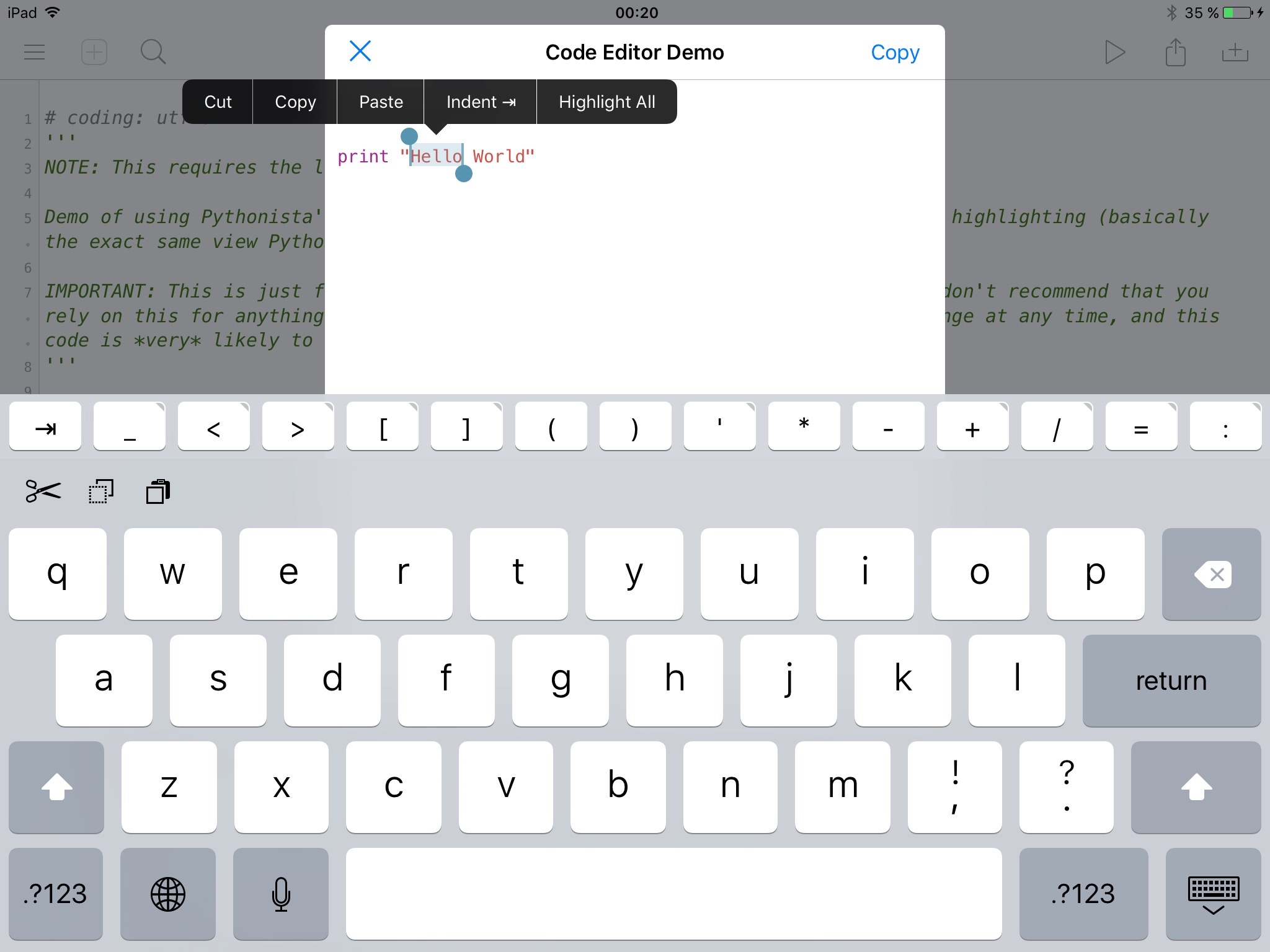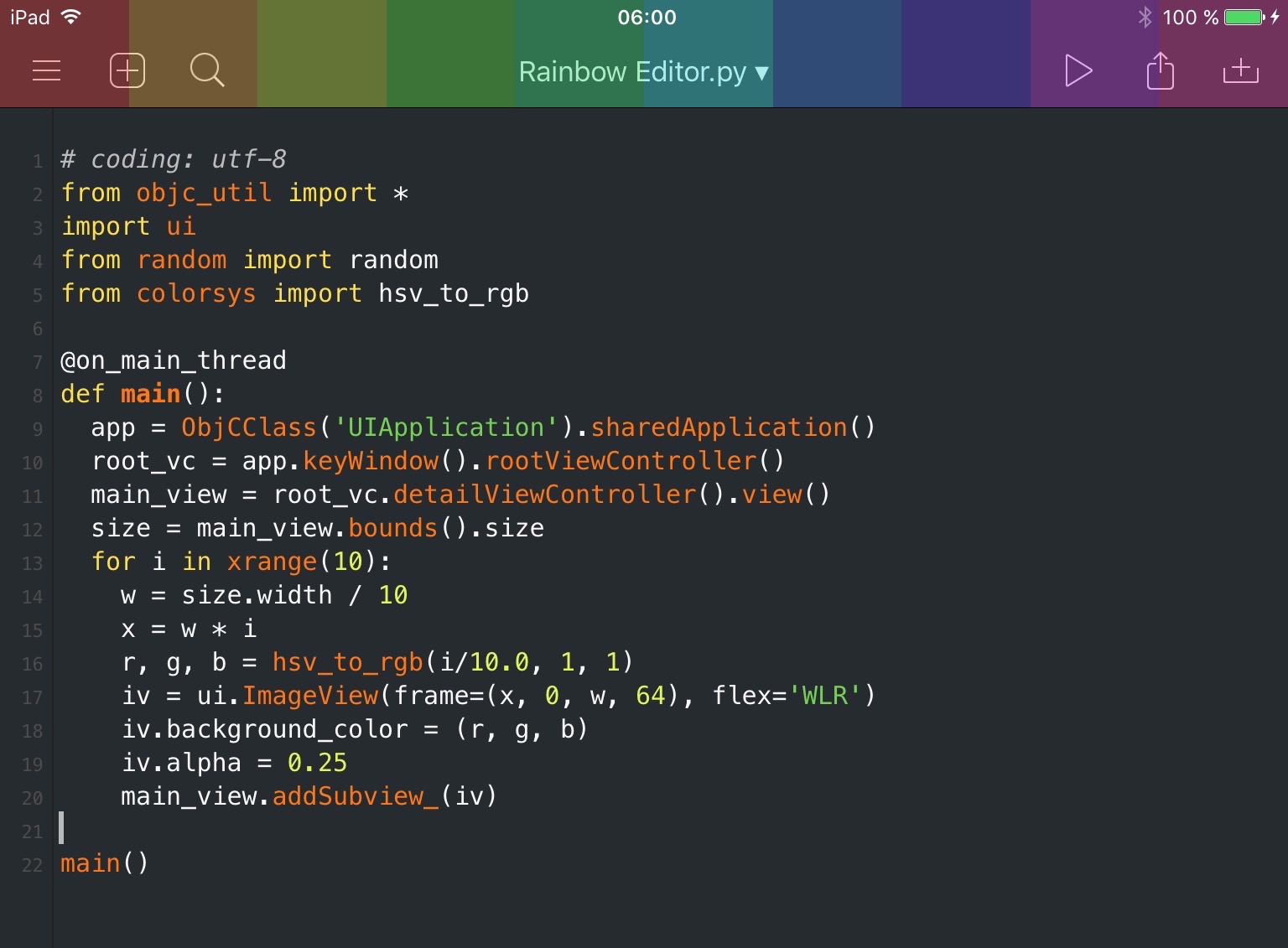Welcome!
This is the community forum for my apps Pythonista and Editorial.
For individual support questions, you can also send an email. If you have a very short question or just want to say hello — I'm @olemoritz on Twitter.
[Beta] Tinkering with Pythonista's internals using objc_util
-
Another
objc_utilexample (yes, I'm really excited about this module)...This one's really just for fun because I wanted to see if I could make it work at all. As the previous MapView example, this is also a custom view class, but of a completely different kind... It uses Pythonista's own code editor, syntax highlighter, and extended keyboard classes, and wraps them in a convenient
ui.Viewpackage.
Here's the code:
It supports Python, HTML, JavaScript, and Markdown for syntax highlighting (there's also a
'text'mode that doesn't highlight anything). The type of extended keyboard is chosen automatically, and it can also be disabled entirely. Things like the "Highlight All" menu item, and automatic character pairs are supported as well.I've mentioned it in the comments, but it's worth pointing out again: Do not rely on this for anything important. It's quite likely to break in the future, but it's fun to play around with. :)
-
Pretty cool,i would make effort to check it out.
-
has 160022 hit testflight yet?
in theory, could this be used to add new butttons to the topline on for the real editor instance? all that empty space between the search button and play button is just begging to be used (now that sidebar mode went away)..
-
has 160022 hit testflight yet?
Now that you mention it, I forgot to send the invites... You should get a notification in a minute or so.
-
Got it!
-
in theory, could this be used to add new butttons to the topline on for the real editor instance? all that empty space between the search button and play button is just begging to be used (now that sidebar mode went away)..
Well, theoretically, you could do all sorts of crazy stuff... ;)

-
I should warn you that you'll probably run into memory management-related crashes when you try to add interactive things (e.g. buttons) to views that aren't managed by the
uimodule.The reason for this is that the reference to the Python object will likely be garbage-collected while the underlying (Objective-C)
UIViewstill exists. You can get around this for example by putting a reference to your view into one of the built-in modules as an attribute (something likeui._keep_this_around = my_view).Another trick to keep an object from being garbage-collected is to force a reference cycle that the garbage collector can't resolve:
my_view._cycle = my_view; my_view.__del__ = lambda x: None(I wouldn't really recommend this approach; while you don't "pollute" any namespace, it's more difficult to get rid of the object when you actually want to). -
I find it super impressive that the new Beta enables you can pass Python objects into ObjC functions and all conversions are automaticly done for you. So cool!!
It was mentioned by someone else in the forum but Ole, have you looked at
cffiin addition to ctypes for Pythonista?Please keep up the awesome work.
-
@ccc, if you want to you can just download and install
cffi. It is written purely in Python, and as long as you set the backend to becffi.backend_ctypes.CTypesBackendit doesn't need a C compiler to work. -
This is super! Thanks Ole! Can't wait for the final product.
-
Hi,
How can i access the Pythonista console view using objc_util?Thanks in advance
Filippo -
here is the method i used to explore the wonderful world of pythonista's view heirarchy. we will search for an objective c object that contains some known text or classname. the custom classes tend to start with OM...
from objc_util import * w=ObjCClass('UIApplication').sharedApplication().keyWindow() main_view=w.rootViewController().view() def filter_subviews(view,text=None, objcclasstext=None): matching_svs=[] sv=view.subviews() if sv is None: return matching_svs for v in sv: if objcclasstext and objcclasstext in v._get_objc_classname(): matching_svs.append(v) if text and hasattr(v,'text'): if str(v.text()) and text in str(v.text()): matching_svs.append(v) matching_svs.extend( filter_subviews(v, text=text, objcclasstext=objcclasstext)) return matching_svs # don't find editor window, so concatenate string print 'find'+'me' # in this case, only one entry will be returned. otherwise, may need to look at list to figure out which view is the one you are seeking. console_view=filter_subviews(main_view,'find'+'me')[0]once you find the thing you are looking for, you can traverse up and down the view heirarchy by using
superviewandsubviews. for instance, maybe you dont want the actual console textview, but you want the text inputconsole_view.superview().subviews()gives a clue, although in some cases you may have to traverse up or down a few levels to find what you are looking for. once you find the classname, note it for future use, as you can search dirsctly for the classname instead.
i also found it useful to walk portions of the subviews, printing out a "tree", where classname, and frame are printed. i eventually thought that a TreeView type object brower might be useful, to browse the tree
-
Thanks
-
@JonB Quick tip:
UIViewhas a built-inrecursiveDescriptionmethod that produces a tree-like representation of all subviews. -
Oh, that's the most useful thing i've ever seen :O
-
Understanding this is for experimentation only, how would one go about modifying
OMPythonSyntaxHighlighteror making a custom syntax highlighter class? -
@nfmusician I don't know anything about NSRegularExpression, but, only for testing, a little modif in @omz code → Code Editor Demo.py (Gist)
allows to change rule for Python comment, from #xxxx into &xxxx
editor_view = OMTextEditorView.alloc().initWithFrame_syntaxHighlighterClass_theme_(f, SyntaxHighlighter, theme) # ============= begin # https://forum.omz-software.com/topic/2014/beta-tinkering-with-pythonista-s-internals-using-objc_util/12 rules = editor_view.syntaxHighlighter().syntaxHighlightingRules() for rule in rules: print(rule.scopeName()) if rule.regex(): print(' NSRegularExpression pattern=',rule.regex().pattern()) if str(rule.scopeName()) == 'comment': #print(dir(rule)) comment_pattern = rule.regex().pattern() comment_pattern = ns(str(comment_pattern).replace('#','&')) comment_options = rule.regex().options() regex_new = ObjCClass('NSRegularExpression').alloc().initWithPattern_options_error_(comment_pattern, comment_options, None) rule.setRegex_(regex_new) print(' NSRegularExpression pattern=',rule.regex().pattern()) print(dir(rule)) # ============= end
-
@nfmusician still only for testing: how to modify color of a rule, here the comment
PA2UITheme = ObjCClass('PA2UITheme') theme_dict = PA2UITheme.sharedTheme().themeDict().mutableCopy() theme_dict.autorelease() theme_dict['font-family'] = 'Menlo-Regular' theme_dict['font-size'] = 14 # ============= begin #print(theme_dict) new_theme_dict = {} for x in theme_dict.allKeys(): #print(x._get_objc_classname(),x) if str(x) == 'scopes': new_dict_scopes = {} for y in theme_dict[x].allKeys(): #print(' ',y._get_objc_classname(),y) if str(y) == 'comment': new_dict_comment = {} for z in theme_dict[x][y].allKeys(): #print(' ','-',z._get_objc_classname(),z) if str(z) == 'color': new_dict_comment[z] = "#DC7633" # new color else: new_dict_comment[z] = theme_dict[x][y][z] new_dict_scopes[y] = new_dict_comment else: new_dict_scopes[y] = theme_dict[x][y] new_theme_dict[x] = new_dict_scopes else: new_theme_dict[x] = theme_dict[x] theme_dict = new_theme_dict #print(theme_dict) # ============= end theme = OMSyntaxHighlighterTheme.alloc().initWithDictionary_(theme_dict) theme.autorelease()
-
Is there a way to mark Python syntax errors like
print “Hello World”in blinkingred? -
@ccc It is only an editor, thus it does not check anything about Python rules. At least' that's what I think. For instance, it recognizes Python reserved words but that's all